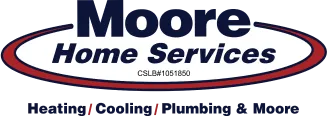My Heater is Not Working but the Thermostat is On
Posted by Moore Home Services
HVAC Basics
We all know how cold it can get during the winter in Santa Rosa. Now imagine you’ve been out all day, you’re ready to come home to a nice warm house, but when you get in the door your heater is not working no matter what setting you change the thermostat to.
It’s really frustrating when the heater is not working but the thermostat is on, here are few reasons why this may be happening.
(Quick note: We normally refer to the furnace as the heater, but in this post, we will use heater and furnace interchangeably.)
The Furnace is On, but Not Heat is Coming Out
Our favorite things about furnaces built after the 1990s is how many safety sensors are in them. The safety sensors can be triggered by something and when they are, only a professional HVAC technician can reset it.
These sensors have saved countless families from fires, carbon monoxide, and other furnace related issues. However, they can be incredibly confusing to many homeowners.
Some of the issues that can trigger a safety sensor are:
A furnace that’s too hot
Carbon monoxide leak
Too much built-up pressure
Broken or leaking gas line
After a safety switch is triggered, it shuts down the entire system. No matter what you do with the thermostat, the system will not be able to start until it has been reset.
In this situation, it’s best to call an HVAC professional if your furnace isn’t creating any heat.
Gas Could be the Reason Your Thermostat Working, but the Heater Isn’t.
Your furnace needs three things to run: water, electricity, and natural gas. Nearly all homes are equipped with a line that receives natural gas from a city or municipal supply.
Natural gas is used for more than your furnace. Many other appliances, like the water heater, dishwasher, and clothing dryer, use natural gas as well.
One of the many reasons your thermostat is working, but your furnace is not could be due to a stuck or broken gas valve or control board.
When this is happening, you can easily test the gas line if you have a gas stove. Simply try to start a burner. If a flame easily starts, there are no problems with your gas line. However, if you can’t get a flame going on the stove, you could be looking at an issue with your gas line.
The Furnace Needs Maintenance Work Done
Hands down, the best way to take care of your HVAC system is to schedule regular tune-ups. At Moore Home Services, we say all homeowners should have two tune-ups per year. Once in the fall before it’s time to start the heater and once in the spring prior to AC season.
During a furnace tune-up, one of our technicians will inspect your entire system. They will take it apart, inspect and clean every piece, put it back together, then test it.
This allows your HVAC tech to see if anything is wrong with your system and make sure your system is running at peak efficiency.
When was the Last Time You Changed Your Air Filter?
Beyond scheduling regular tune-ups, the best thing you can do for your HVAC system, and your home, is to regularly check and change your air filter. The air filter is a small part with a big job.
Air filters keep dust and other debris from settling in and clogging parts of your HVAC system. They also trap airborne contaminates that could make you, or your family, sick.
No matter what type of air filter you have, it will get full. A full air filter is an air filter that’s properly doing its job. This means that you should be regularly checking your air filter because a clogged air filter will cost you money and can potentially stop your airflow.
When an air filter is clean, air can freely pass through it. But when it’s overfull or clogged, air has to be forced through. This means your furnace is doing the brunt of the work. The extra strain adds up on your monthly utility bill. An overfill air filter can also be to blame when your thermostat is working, but the heater is not.
Is Your Furnace Short Cycling?
Your home heats on a cycle. A cycle begins when the thermostat sends a signal to the HVAC system that air needs to be heated. The furnace then pulls in ambient air from your home. The air is heat treated then sent back into your home. This cycle lasts as long as it takes to heat your home, around 15 to 20 minutes.
When your home won’t properly heat or gets hot too fast, it could be attributed to short cycling. Some other reasons your furnace will short cycle are if:
The furnace itself is overheating
The air filter is too dirty and too full of debris
Your flame sensor isn’t working
The thermostat is in the wrong spot
Your Furnace is too big for your home
Looking for the best HVAC service in Santa Rosa? Look no further than Moore Home Services. To schedule an appointment, call the number at the top of the screen or click here to book online.


